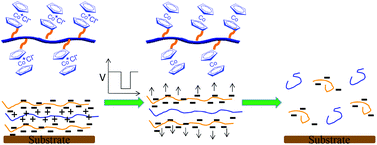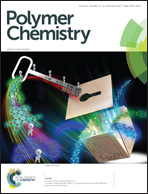Electric-stimulus-responsive multilayer films based on a cobaltocenium-containing polymer†
Abstract
Robust fabrication of electroactive multilayer films from a cationic metallocene-containing polymer and their redox-controlled disassembly are presented. Multilayers are assembled from the cationic cobaltocenium polymer (PMCl) and anionic poly(styrene sulfonate) (PSS), and the effect of salt on the assembly process is investigated. Both electrochemical surface plasmon resonance spectroscopy and electrochemical quartz crystal microbalance confirm excellent response properties of the multilayer film to the electric potential. At an appropriate voltage (≤−0.7 V) these multilayer films undergo rapid disassembly due to reduction of the cationic cobaltocenium to neutral cobaltocene in PMCl and disappearance of the electrostatic interactions holding the polymers together. The extent of disassembly is linearly dependent on the time when the voltage is applied, and the film completely disintegrates from the substrate surface in several minutes. Furthermore, the PMCl/PSS film is employed as a switch layer, and upon electric stimulus the disintegration of the switch layer leads to rapid and complete release from the substrate surface of the overlaying poly(diallyldimethylammonium chloride)/PSS multilayer, which is not electro-responsive.


 Please wait while we load your content...
Please wait while we load your content...